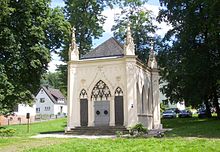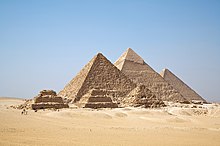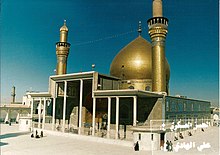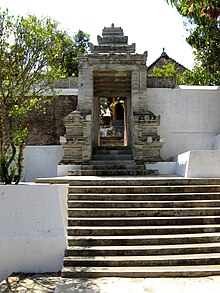mausoleum

A mausoleum is a monumental tomb in the shape of a building. The expression is derived from Maussol-eion , the tomb of Maussolos belonging to the ancient seven wonders of the world in Halicarnassus (today Bodrum ), dedicated to the governor of Caria on the west coast of today's Turkey between 377 and 353 BC. Chr.
The word mausoleum has been documented in German-language literature since the 16th century. This tomb type of antiquity was reactivated in classicism, albeit in a smaller form. These are often two-storey architectures, consisting of a prayer room and an underlying crypt, whereby the crypt and chapel can be combined in one room above ground. Functionally, these modern mausoleums form a hybrid form of building and monument and, within the sepulchral culture, fulfill the aspects of commemoration of the dead, representation and appeal to posterity.
Mausoleums in Islam

Mazār ( Arabic مزار 'Place to be visited; Place of pilgrimage; Sanctuary ') is a mausoleum or shrine , primarily a burial place of a famous or "holy" Muslim personality. In Middle Arabic, terms such as mašhad, maqām or ḍarīḥ are used analogously. In Palestine and in scientific literature, these sites are also referred to as wali or weli . They are often associated with a certain popular belief , but also with syncretic elements. The followers of the strict sect of the Wahhabis , the Salafists (from Arabic سلف الصالحين, DMG salaf aṣ-ṣāliḥīn 'ancestors of the virtuous'), attach great importance to the fact that no human being can mediate between man and God. They hold Muslims who are "holy personalities" ( Arabic اولياء الله, DMG Aulīya 'Allaah' Friends of God ') and worship their shrines, for heretics . In 1802, Wahhabi troops captured Karbala and partially destroyed the shrine of Imam Husayn . In 1925, the commander and later King of Saudi Arabia , Saud I ibn Abd al-Aziz , destroyed the mausoleums of the Baqīʿ al-Gharqad ( Arabic بقيع الغرقد, DMG baqī 'al-ġarqad ) in Medina , the burial place of four of the Shia imams and of Fātima bint Muhammad . The cemetery was completely destroyed in 1926 under Abd al-Aziz ibn Saud , but it still serves as a cemetery.
There are no specific architectural types for mazārat that vary widely in size and finish. What they all have in common is a turba ( Arabic تربة 'Grave, burial place, tomb'), a grave in the center, which is usually rectangular.
etymology
Mazār (plural mazārāt ) goes back to the word ziyāra ( Arabic زيارة) meaning "(reverently) visiting". It refers to specific places and times.
Distinctions
- Mashhad ( Arabic مشهد, DMG Mašhad , pluralمشاهد, DMG Mašāhid 'place of martyrdom (of the martyrdom)') often also refers to a tomb of a saint or the place where a religious experience (e.g. martyrdom) took place. With this designation are the wordsشاهد, DMG šāhid 'witness' andشهيد, DMG šahīd 'Martyrs, Blood Witnesses'. The city of Mashhad in Iran got its name from Mašhad , which means "place of martyrdom", since the eighth Imam Ali Al-Ridha is said to have become a martyr here. A Mashhad often has a canopy or dome over the burial place in the building. Sometimes it also has a minaret .
- Maqam ( Arabic مقام, DMG maqām , pluralمقامات, DMG maqāmāt , literally translated “place on which something is built”, also “location”) is the name that is often used for Ahl al-bait shrines (memorials for members of the family of Mohammed). Ibn Taymiyya writes that the maqāmāt are places where the venerated person lived, died or was religiously active, and the maschāhid are buildings over the maqāmāt or over relics of the person.
- Darīh ( Arabic ضريح, DMG ḍarīḥ 'grave, burial place, mausoleum', pluralاضرحة, DMG aḍriḥa ) is a depression in the middle of the grave, but also designates the grave itself.
Regional names
- Mazār was adopted as an Arabic loan word in Persian and Urdu . Therefore it is used in Iran and other countries with Persian culture, especially in Afghanistan , Pakistan and India .
- Walī (singular from Arabic اولياء, DMG Auliyā '' friend [of God] '): In Palestine this term is used both for a saint and for his memorial or his tomb. The memorial of a prophet is also called Arabic حضرة, DMG ḥaḍra 'presence, presence' (at the same time a salutation for a higher personality), while that of an ordinary saint is a maqam and that of a famous saint is a Mashhad . In the 19th and 20th centuries, the name walī , also via Turkish veli as "Weli" or "Welli", was adopted into Western literature.
- Qubba ( Arabic قبة 'Dome', plural قباب, DMG qibāb andقبب, DMG qubab , Persian گنبد, DMG gonbad , 'dome') grave building or place of worship of a saint. In popular Islam there is the idea that a holy man passes on his baraka (“blessing power”) through his grave even after death. This makes the tomb a source of baraka and thus also a place of ziyāra (pilgrimage). A holy man is called a wale , faki or sheikh in Sudan .
- Aramgah ( Persian آرامگاه, DMG ārāmgāh , 'resting place') is a common term in the Persian-speaking area for a mausoleum or tomb.
- In Iran, smaller shrines in the form of a mosque are called Imamzadeh ( Persian امازاده, DMG emāmzāde , 'descendant of an imam', also "tomb of an imam descendant").
- Occasionally, shrines of Sufi masters in Iran are also referred to as dargāh .
- In northwest China, gongbei ("dome") are built over the grave of Sufi masters of the Hui Chinese .
- In South Africa (especially in the Western Cape region ) a kramat (from Arabic كرامة, DMG karāma [t] , miracle, miracle deed [ of saints] ') the grave of a spiritual leader or “friend of God” ( Walī Allāh ), often within a rectangular building that serves as a mausoleum (mostly for Cape Malay ).
- In Indonesia , the words makam and kuburan refer to the graves of the early missionaries, especially those of the Walisongo (nine saints) of Java .
Well-known mausoleums


Afghanistan
- Chirqa Sharīfa ( Persian خرقه شريفه, DMG ḫirqa šarīfa "penitent shirt of the noble one") in Kandahar . It contains a cloak that is attributed to Mohammed.
- Ali mausoleum in Mazar-e Sharif , one of the alleged burial places of Ali .
Egypt
In Cairo , the shrines date from the Fatimid period and are mostly simple, rectangular structures with a dome. Some of the mausoleums at Aswan were more complex and had side rooms. Most, however, have been destroyed or completely rebuilt
- Mashad al-Juyushi , (also: Mashad Badr al-Jamali, الجامع الجيوشى) is an exception. The mosque has a cross-vaulted prayer hall and a dome on trumpets over the mihrab .
- Mashads by Sayyida Ruqayya , in Cairo, Fustāt cemetery
- Mashads from Yayha al-Shabib , Fustat Cemetery.
- Aga Khan III mausoleum in Aswan
- Abu Al Hassan El-Shazly Mausoleum in Sheikh Shazly (الشيخ الشاذلى) (also: Ḥumaythirah, حميثرة)
Bangladesh
China
- Mausoleum of the first emperor of China, Qin Shihuangdi , in Xi'an with its terracotta army ( UNESCO World Heritage Site )
- Mao Zedong Mausoleum in Beijing
- Sun Yat-sen Mausoleum in Nanjing
- Taiwan
- The mausoleum of Chiang Kai-shek and Chiang Ching-kuo in Daxi , Taoyuan
- National Chiang Kai-shek Memorial Hall in Taipei
India
- Humayun's Mausoleum in Delhi ( UNESCO World Heritage Site )
- Akbar Mausoleum in Sikandra
- Itimad-ud-Daula mausoleum in Agra
- Taj Mahal ( UNESCO World Heritage Site ) in Agra
- Bibi-Ka-Maqbara in Aurangabad
- Safdarjung mausoleum in Delhi
- Gol Gumbaz , mausoleum of Sultan Mohammed Adil Shah, in Bijapur
- Dargah Nizamuddin , tomb of the founder of the Chisti Nizami order in Delhi
- Laila Majnu Ki Mazar , near Anupgarh , Rajasthan . Local legends tell that Laila and Majnun died there.
- The mausoleum of Fakhruddin Shaheed in Galiakot , Rajasthan.
Indonesia
- Imogiri on Java , mausoleum of the Sultans of Mataram , Yogyakarta and Surakarta .
Iraq
- Imam Husain shrine in Karbala .
- Sardāb of Caliph al-Mahdi (~ 775–785) in Samarra . The golden cathedral was donated by Nāser ad-Din Shah and completed in 1905 by Mozaffar ad-Din Shah . The actual tomb is in the Al-Askari Mosque and is one of the most important shrines of the Shia. The mosque was badly damaged in February 2006.
Iran
- Mausoleum of Fariduddin Attar in Nishapur
- Mausoleum for King Kabus in Golestan Province
- Charaghan twin tomb towers , in Qazvin Province
- Tomb of the Poets , in the province of Tabriz
- Imam Reza Shrine , in Mashhad , Razavi Khorasan attracts 11 million believers every year
- Princess Shahrbanu's shrine , south of Tehran , is only open to women. Shahrbanu was the daughter of Yazdegerd III. , the last Sassanid ruler . She married Imam al-Husain ibn ʿAlī and is the mother of the fourth Imam, Ali ibn al-Husayn .
- Mausoleum for Avicenna in Hamadan
Kyrgyzstan
- Manas Ordo Mausoleum of Manas in Talas
Korea
- Kim Il Sung mausoleum in the converted Kumsusan Palace in Pyongyang
Mongolia
- Damdin Süchbaatar's and Chorloogiin Tschoibalsan's mausoleum in Ulaanbaatar , in 2005 both corpses were exhumed, cremated and buried in Altan-Ölgii .
Pakistan
- Mazar-E-Quaid for the founder of the state Mohammed Ali Jinnah in Karachi / Pakistan
- Shrine of Abdol-Ghazi Sahab in Karachi, a relative of Jafar as-Sādiq , the sixth imam. He had fled to Sindh from the Abbasids in Baghdad . One of the few shrines that is simultaneously venerated by Shias and Sunnis.
- Jahangir mausoleum near Lahore / Pakistan
- Bibi Pak Daman , the shrine is considered to be the burial place of six women from the house of the Prophet. The Sufi master Hudschwīrī meditated there for some time.
- Data Darbar (Shrine of Data Ganj Baksh), at Bhati Gate , in Lahore .
- Mazar of Sultan Bahu (سُلطان باہُو), the founder of the Sarwari Qadri order in Garh Maharaja , in Lahore
Syria
- Shrine Zainab bint Alis , the shrine of Zainab bint Ali in Damascus . In September 2008, a car bomb exploded outside the mosque, killing 17 people.

- Mashhad al-Husayn (Maschhad Al-Nuqtah), Aleppo , from the Ayyubid period is the most important medieval building in Syria. The shrine of the blood of al-Hussain ibn ʿAlī was built in a place indicated to a shepherd by a saint when he appeared to him in a dream. The current building is a reconstruction: the original building was badly damaged by an explosion in 1918 and lay in ruins for forty years.
Turkey
- Mausoleum of Halicarnassus ( tomb of the governor Maussolos of Caria) in Bodrum / Turkey , one of the seven wonders of the ancient world
- Mevlânâ mausoleum of Jalal ad-Din ar-Rumi in Konya
- Anıtkabir - Ataturk's tomb in Ankara
Turkistan
Uzbekistan
- Timur Lenk mausoleum " Gur-e Amir " in Samarkand
- Mausoleum of Sheihantaur in Tashkent
Vietnam
- Ho Chi Minh mausoleum in Hanoi on Ba Dinh Square .
America
- Che Guevara mausoleum in Santa Clara / Cuba
- Bob Marley mausoleum in Nine Miles / Jamaica
- " Grant 's Tomb" in New York City / USA (largest mausoleum in North America)
- Chullpas , burial towers from the Inca period and before that in South America
Africa
In Africa, are the tombs of pharaohs in the Valley of the Kings at Luxor , but especially the one of the 7 Wonders of the Ancient counting Pyramids of Giza to name, who are also expected also the oldest mausoleums of the world. Other pyramid tombs can be found in Nubia .
- Mausoleum of the Pharaoh Cheops
- Mausoleum of Pharaoh Chephren
- Mausoleum of Pharaoh Mykerinos
- Mausoleum of King Djoser
- Mausoleum of Pharaoh Tutankhamun
Maghreb
- Mausoleum of President Habib Bourguiba in Monastir
- Mausoleum of King Mohammed V in Rabat
Europe
Bulgaria
- Georgi Dimitrov Mausoleum in Sofia . After 1990 Georgi Dimitrov was buried in the central cemetery in Sofia . The mausoleum was blown up in 1999.
Germany


- Wettin mausoleum at the hereditary burial site on the site of the Altzella monastery
- Princely crypt chapel in Anholt
- Mausoleum of the East Frisian noble family Cirksena in Aurich , East Frisia
- Stourdza Chapel - Romanian Orthodox burial chapel in Baden-Baden
- Mausoleum in the Charlottenburg Palace Park in Berlin, built for Queen Luise
- Arnim burial place in the park of Boitzenburg Castle
- Mausoleum of the Mertés family in Bad Breisig
- Mausoleum in the Bückeburg palace park of the princes of Schaumburg-Lippe
- Pyramid-shaped mausoleum of Wilhelm (Schaumburg-Lippe) near Baum Castle near Bückeburg
- Ducal mausoleum in Coburg
- Old mausoleum in Rosenhöhe Park in Darmstadt
- New mausoleum in Rosenhöhe Park in Darmstadt
- Herff's tomb in the Rosenhöhe Park in Darmstadt
- Pyramid-shaped mausoleum of Ernst zu Münster near Derneburg Castle
- Mausoleum of the Dukes of Anhalt in Dessau
- Mausoleum on Büchenberg for the Lippe house in Detmold
- Mausoleum of the princes of Wied-Runkel in Dierdorf , Westerwald
- Mausoleum of Karl August Lingner , inventor of the Odol mouthwash on the grounds of the Lingnerschloss (actually Villa Stockhausen ) in Dresden , Saxony
- Family crypt Peill in Düren
- Grave pyramid in the Hämelschenburg Castle Landscape Park in Emmerthal
- Stollwerck mausoleum in Feldkirchen-Westerham , Upper Bavaria
- Mausoleums in the main cemetery in Frankfurt am Main
- Bismarck mausoleum in Friedrichsruh
- Kanitz-Kyaw's crypt in Hainewalde
- Welf mausoleum in the Berggarten of Hanover
- Grave chapel of the Grand Ducal Baden family in the pheasant garden in Karlsruhe
- Mausoleum of the Selve family in Lüdenscheid
- Helenen Paulownen mausoleum in the palace gardens of Ludwigslust
- Louisen mausoleum in the Ludwigslust palace gardens
- Emil von Behring's mausoleum in Marburg-Marbach
- Ducal crypt chapel in the English Garden of Meiningen
- Asseburg's hereditary burial in Meisdorf
- Tenge Mausoleum in Oerlinghausen
- Mausoleum of the Grand Dukes of Oldenburg in Oldenburg
- Carstanjen mausoleum in Plittersdorf
- Kaiser Friedrich Mausoleum in Potsdam
- Goetzsche's mausoleum in Quedlinburg
- Mausoleum of the princes of Bentheim-Tecklenburg in Rheda-Wiedenbrück
- Opel mausoleum in Rüsselsheim
- Princely burial chapel of the House of Schwarzburg-Sondershausen in Sondershausen
- Mausoleum of the princes of Schaumburg-Lippe in Stadthagen
- The burial chapel on the Württemberg in Stuttgart-Rotenberg , the mausoleum for Queen Katharina Pavlovna
- Crypt chapel of the Barons of Gemmingen in Treschklingen
- Mausoleum of the Dannenfeldt family in the Mönchow cemetery in Usedom
- Grave chapel of St. Benedict of the von Boeselager family in Vosswinkel
- Hermann Weil mausoleum in Waibstadt
- Mausoleum of the Princes of Reuss older line in Waldhaus near Greiz
- Knoop Mausoleum in Walle
- Princely crypt in the historical cemetery in Weimar
France
- Mausolée du Maréchal de Saxe in St. Thomas, Strasbourg , built for Hermann Moritz of Saxony
Greece
Italy
Ancient mausoleums
- Cestius pyramid in Rome
- Castel Sant'Angelo in Rome
- Mausoleum of Augustus in Rome
- Tomb of Caecilia Metella on the Via Appia in Rome
Early Christian mausoleums
- Helena's Mausoleum in Rome
- Santa Costanza in Rome (Mausoleum of Constantina)
- Galla Placidia Mausoleum in Ravenna
- Mausoleum of Theodoric in Ravenna
Croatia
- The mausoleum of Ivan Meštrović (in which he and his family members were buried) in the village of Otavice near Drniš ( Dalmatia ).
- Mausoleum of Emperor Diocletian in Split . (Inside the palace walls of Diocletian's Palace)
Netherlands
- Mausoleum of the German Emperor Wilhelm II in the park of Haus Doorn
Austria
- Mausoleum of Ruprecht von Eggenberg in Ehrenhausen , Styria
- Mausoleum of Emperor Ferdinand II in Graz
- Goldburg mausoleum in Murstetten , Lower Austria
Poland
- Mausoleum of the family of Prince Anton Radziwill in the Antonin Castle Park near Poznan
- Mausoleum of the von Hoym family in Dyhernfurth in Silesia
- Mausoleum of Count Yorck von Wartenburg in the castle park of Klein Oels in Lower Silesia
- Blücher mausoleum in Krieblowitz in Silesia
- Grave chapel of the Henckel von Donnersmarck family near Neudeck Castle in Upper Silesia
- Pyramid in Rapa in Masuria
Russia
- Lenin mausoleum in Moscow / Russia on Red Square
Serbia
- The House of Flowers , now part of the Museum of the History of Yugoslavia in Belgrade , grave of Josip Broz (Tito)
Spain
- Mausoleum L. Aemilius Lupus in Fabara, Zaragoza Province, Aragon
- Mausoleum of the Attilians in Sádaba, Saragossa Province, Aragon
Czech Republic
- Klement Gottwald mausoleum on St. Vitus Hill in Prague (mummy was removed in 1962 due to decay)
United Kingdom
- Mausoleum in the Scottish city of Penicuik
See also
Individual evidence
- ↑ Helke Kammerer-Grothaus: Antikenrezeption und Grabkunst. In: From the churchyard to the cemetery. Change processes between 1750 and 1850. Symposium from May 11th - 13th 1981 in Mülheim / Ruhr on the research project recording and documentation of the sepulchral culture of Classicism, Romanticism and Biedermeier, working group cemetery and monument in Kassel. Kassel 1984, ISBN 3-924447-04-7 , pp. 125-136, p. 125. (Kassel Studies on Sepulchral Culture, Volume 2)
- ^ Norbert Fischer: From Gottesacker to the crematorium: a social history of the cemeteries in Germany since the 18th century. Diss. Phil. Hamburg 1996. Böhlau, Cologne / Weimar / Vienna 1996, ISBN 3-412-11195-3 , p. 66.
- ↑ See H. Wehr: Arabic dictionary for the written language of the present , Wiesbaden 1968, p. 350.
- ↑ Sandouby 2008: 14th
- ↑ See H. Wehr: Arabic Dictionary , pp. 385 and 474.
- ^ J. Spencer Trimingham: The Sufi Orders in Islam . Oxford University Press, July 16, 1998, ISBN 9780198028239 , p. 105.
- ^ Nasr 2007: 97.
- ^ Nasr 2007: 97; Loring M. Danforth: Crossing the Kingdom: Portraits of Saudi Arabia . Univ. of California Press, March 29, 2016, ISBN 9780520290280 , p. 163.
- ^ Houtsma 1993: 425.
- ↑ Sandouby 2008: 16.
- ↑ Sandouby 2008. p. 14.
- ↑ Halm 2007: 26.
- ↑ Sandouby 2008: 17.
- ↑ Sandouby 2008: 15.
- ↑ Sandouby 2008: 16.
- ↑ See H. Wehr: Arabic Dictionary , Wiesbaden 1968, p. 490.
- ↑ Sandouby 2008: 15.
- ^ Moshe Sharon : Corpus Inscriptionum Arabicarum Palaestinae (CIAP), Volume Two: BC . Brill Academic Publishing, 1998, ISBN 9789004110830 , p. 172 (accessed January 3, 2015).
- ↑ Guérin, 1880: 488
- ↑ See H. Wehr: Arabic Dictionary , Wiesbaden 1968, p. 658.
- ^ Robert S. Kramer, Richard A. Lobban Jr., Carolyn Fluehr-Lobban: Historical Dictionary of the Sudan (= Historical Dictionaries of Africa), 4th edition, Scarecrow Press, an imprint of Rowman & Littlefield, Lanham, Maryland, USA 2013, ISBN 978-0-8108-6180-0 , p. 361 (accessed on May 2, 2015): “QUBBA. The Arabic name for the tomb of a holy man ... A qubba is usually erected over the grave of a holy man identified variously as wali (saint), faki, or shaykh since, according to folk Islam, this is where his baraka [ blessings] is believed to be strongest ... "
- ↑ See H. Wehr: Arabic Dictionary , Wiesbaden 1968, p. 732.
- ↑ Cf. Junker / Alavi: Persian-German Dictionary , Leipzig / Teheran 1970, p. 271; DMG after the Afghan debate.
- ^ Kuiper 2009: 164.
- ↑ Petersen 2002: 45.
- ↑ Petersen 2002: 45-46.
- ↑ Houtsma 1993: 488.
- ↑ Rabasa, Chalk, Cragin 2006: 51.
- ^ Nasr 2007: 63.
- ↑ B. Tayefeh-Mahmoudi: The Persian doctor and philosopher Avicenna (Ibn Sina). Medical dissertation Düsseldorf 1964, pp. 70-79.
- ^ Nasr 2007: 58.
- ^ Nasr 2007: 58-59.
- ^ Nasr 2007: 56.
- ↑ Tabbaa 1997: 110.
- ↑ Tabbaa 1997: 111.
- ↑ Tabbaa 1997: 110.
- ^ Hugo Brandenburg: The early Christian churches in Rome from the 4th to the 7th century. Schnell & Steiner, Regensburg 2013, p. 56ff.
- ↑ Hans Georg Wehrens: Rome - The Christian sacred buildings from the 4th to the 9th century - A Vademecum. Herder, Freiburg, 2nd edition 2017, pp. 90ff.
- ↑ Carola Jäggi: Ravenna - art and culture of a late antique residence city. Schnell & Steiner, Regensburg 2016
- ↑ Carola Jäggi: Ravenna - art and culture of a late antique residence city. Schnell & Steiner, Regensburg 2016
literature
- JJ Roy Burman: Hindu-Muslim Syncretic Shrines and Communities . Mittal Publications, 2002, ISBN 978-81-7099-839-6 (accessed March 12, 2013).
- Heinz Halm: The shiites: a short history . Markus Wiener Publishers, July 1, 2007, ISBN 978-1-55876-436-1 (accessed March 12, 2013).
- M. Th Houtsma: First Encyclopaedia of Islam: 1913-1936 . BRILL, 1993, ISBN 978-90-04-09796-4 , p. 425 (accessed March 12, 2013).
- Kathleen Kuiper: Islamic Art, Literature, and Culture . The Rosen Publishing Group, December 11, 2009, ISBN 978-1-61530-097-6, (accessed March 12, 2013).
- Vali Nasr: The Shia Revival: How Conflicts within Islam Will Shape the Future . WW Norton & Company, April 17, 2007, ISBN 978-0-393-06640-1, (accessed March 13, 2013).
- Andrew Petersen: Dictionary of Islamic Architecture . Taylor & Francis, March 11, 2002, ISBN 978-0-203-20387-3, (accessed March 12, 2013).
- Angel Rabasa, Peter Chalk, Kim Cragin, Sara A. Daly, Heather S. Gregg: Beyond al-Qaeda: Part 2, The Outer Rings of the Terrorist Universe . Rand Corporation, 2006, ISBN 978-0-8330-4105-0, (accessed March 12, 2013).
- Aliaa Ezzeldin Ismail Sandouby: The Ahl Al-bayt in Cairo and Damascus: The Dynamics of Making Shrines for the Family of the Prophet . ProQuest, 2008, ISBN 978-0-549-72466-7 , p. 14 (accessed March 12, 2013).
- Syrian car bomb attack kills 17th BBC News September 27, 2008
- Yasser Tabbaa: Constructions of Power and Piety in Medieval Aleppo . Penn State Press, 1997, ISBN 978-0-271-04331-9 , p. 110 (Accessed March 12, 2013).




















